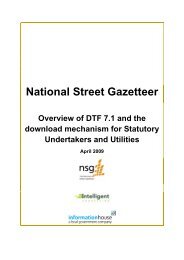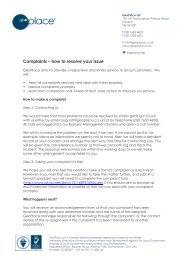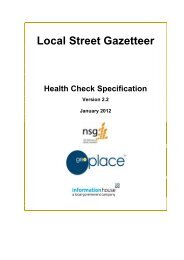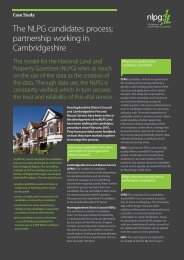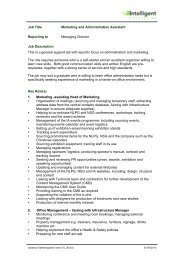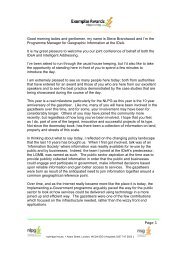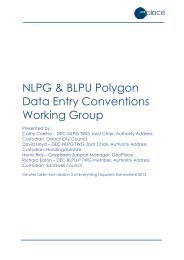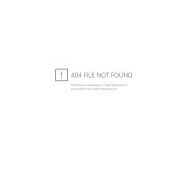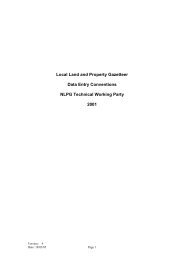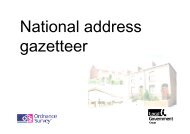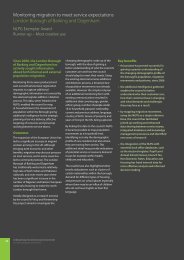NLPG Guidance Document 1: Developing and ... - Iahub.net
NLPG Guidance Document 1: Developing and ... - Iahub.net
NLPG Guidance Document 1: Developing and ... - Iahub.net
Create successful ePaper yourself
Turn your PDF publications into a flip-book with our unique Google optimized e-Paper software.
Produced by Intelligent Addressingnlpg<strong>NLPG</strong> <strong>Guidance</strong> <strong>Document</strong> 1:The NationalL<strong>and</strong> & Property Gazetteer<strong>Developing</strong> <strong>and</strong> implementing a LLPG froman extract from the <strong>NLPG</strong>
This guidance document, issued by the <strong>NLPG</strong> Custodian, is essential reading for all localauthority l<strong>and</strong> <strong>and</strong> property gazetteer custodians. It aims to raise awareness of themethodology that needs to be put in place to ensure that a local l<strong>and</strong> <strong>and</strong> propertygazetteer (LLPG) is both kept up-to-date at the local level <strong>and</strong> also in synch with thenational dataset. More importantly this document aims to assist a local l<strong>and</strong> <strong>and</strong> propertygazetteer custodian in implementing <strong>and</strong> developing a LLPG based on an extract from the<strong>NLPG</strong>.For any LLPG custodian an underst<strong>and</strong>ing of BS7666 (2000) is required. It is alsoessential that you are familiar with the <strong>NLPG</strong> Data Transfer Format (DTF) <strong>and</strong> the generalprinciples behind the benefits of creating <strong>and</strong> maintaining a LLPG <strong>and</strong> its importance withinthe <strong>NLPG</strong>. It is advisable that you seek confirmation from software suppliers <strong>and</strong> dataconsultants involved in any part of your LLPG that they are also incorporating BS7666 intotheir LLPG platforms or that any data cleaning/matching processes will facilitate your localauthority's participation in the <strong>NLPG</strong>. For an up-to-date list of accredited software suppliersplease see the <strong>NLPG</strong> web site www.nlpg.org.uk for more information. IDeA are also in theprocess of accrediting data consultants offering address cleaning/matching services toascertain their compliance with the whole BS7666 LLPG creation process <strong>and</strong> ability to linkto <strong>NLPG</strong>.BackgroundThe <strong>NLPG</strong> has now been created for Engl<strong>and</strong> <strong>and</strong> Wales <strong>and</strong> is being used by theNational L<strong>and</strong> Information System (NLIS) to automate the search aspect of theconveyancing process. The <strong>NLPG</strong> is made up from two distinct sources which have beenmerged <strong>and</strong> matched together to form its composite structure. These sources are:(i)(ii)existing local authorities that have submitted their own BS7666 compliant LLPGs tothe <strong>NLPG</strong> hubnational datasets provided by the Valuation Office (Council Tax <strong>and</strong> Non DomesticRates); ADDRESSPOINT for some co-ordinate information; the National StreetGazetteer, <strong>and</strong> a commercial property gazetteer provided by Property IntelligencePlc.Those local authorities that successfully submitted their own LLPGs to the first build of<strong>NLPG</strong> were able to retain any existing Unique Property Reference Numbers (UPRNs) usedin their gazetteers. The remaining part of the national dataset has had UPRNs allocated toeach of the BLPU entries by the <strong>NLPG</strong> custodian. One of the fundamental aspects to theworkings of the <strong>NLPG</strong> is the UPRN. These numbers are unique across Engl<strong>and</strong> <strong>and</strong>Wales <strong>and</strong> now that the <strong>NLPG</strong> is being used by other organisations, are fixed <strong>and</strong> will notchange over time. If a property or l<strong>and</strong> parcel ceases to exist the respective UPRNassociated with the property will simply be 'closed' or marked for deletion <strong>and</strong> thenarchived. This means that the same UPRN will not be used <strong>and</strong> possible future duplicationis avoided.<strong>NLPG</strong> <strong>Guidance</strong> <strong>Document</strong> 1 v1.3 April 20031
First Steps to obtaining your <strong>NLPG</strong> extractFor many local custodians a LLPG <strong>and</strong> its subsequent link to the <strong>NLPG</strong> isconnected with Best Value <strong>and</strong> addressing e-government targets for citizencentred service delivery. Consequently the development of a definitive index ofplaces within a local authority administrative area is of importance in identifyingways of improving service delivery <strong>and</strong> meeting these Best Value targets. Thisprocess is something that the Improvement <strong>and</strong> Development Agency for LocalGovernment (IDeA) through the Local Government Information House (LGIH) arekeen to measure.Consequently, in order to release the data to you your authority will need to havesigned <strong>and</strong> returned the <strong>NLPG</strong> Licence Agreement between LGIH <strong>and</strong> your localauthority. This licence agreement was sent to the Chief Executive of all District,Metropolitan <strong>and</strong> Unitary Authorities in August 2000. If your local authority hasnot signed this agreement or you require another copy please contact StevenBr<strong>and</strong>wood at IDeA (steven.br<strong>and</strong>wood@idea.gov.uk or tel 020 7296 6615) .Data FormatThe extract of your local authority LLPG from the <strong>NLPG</strong> will be supplied to you inthe <strong>NLPG</strong> Data Transfer Format. This is a BS7666 compliant data specificationtherefore any software application you are using must be able to support a file ofthis nature. You can specify that the data be supplied to you in either DataTransfer Format version 5.3 or version 6.3.Note - a copy of the relevant data transfer format specification is supplied on theCD ROM with a copy of your <strong>NLPG</strong> extract. Alternatively a copy is available todownload from the <strong>NLPG</strong> web site.Important Information for LLPG Custodians1. Retention of UPRNSAs the UPRNs contained in the <strong>NLPG</strong> are already in use by other third partiessuch as NLIS <strong>and</strong> its associated partners, the UPRNs contained within the <strong>NLPG</strong>extract need to be retained in any subsequent LLPG your authority creates. Youmay undertake this by maintaining a simple cross-reference table between thenational UPRN <strong>and</strong> your own referencing number; renumbering other applicationdata with the UPRN from the <strong>NLPG</strong>; or by adding a UPRN field into existingapplications <strong>and</strong> populating this field with the corresponding <strong>NLPG</strong> UPRN.Similarly the addresses/BLPUs that these UPRNs are allocated to need to beretained, i.e. it is not possible to renumber BLPUs with a different UPRN albeitwithin the same UPRN range supplied in the extract you have. For example thedata contained within the <strong>NLPG</strong> for your local authority area may contain anumber of BLPUs <strong>and</strong> associated records within the number range 23000001 to23500001. Each of these numbers will be associated to differing 'addresses'.For example the following LPI entry may occur,<strong>NLPG</strong> <strong>Guidance</strong> <strong>Document</strong> 1 v1.3 April 2003 2
UPRN 23000001SAONFIRST FLOOR FLATPAONALPHA HOUSEUSRN(street) 4013453(Church Street)Any data that you match to this address (for example Flat A, Alpha House or Flat 1, AlphaHouse) must retain this UPRN of 23000001. In this case two alternative LPIs will then becreated for this BLPU both with the same UPRN. Likewise it is not possible to takeanother number in the number range <strong>and</strong> allocate the UPRN of say 23111112 to thisBLPU/address.Therefore you need to use the <strong>NLPG</strong> dataset as the basis to match other applicationdatasets to <strong>and</strong> not simply extract the UPRN range.2. Street DataThe extract from the <strong>NLPG</strong> for your local authority area may contain a number of LPIsthat have been matched to temporary USRNs. These USRNs all have the USRN prefix of'77' <strong>and</strong> reference streets that cannot be located in the National Street Gazetteer for yourarea. A requirement of BS7666 is that all BLPUs are referenced to a street. Thereforerather than omit these BLPUs from your dataset the associated streets have beenassigned a temporary value/entry in the <strong>NLPG</strong>.You will need to resolve any occurrences of the temporary USRNs during your datamatching/cleaning exercise. As much information as possible has been retained for eachBLPU/LPI in terms of street descriptor, locality, town <strong>and</strong> county etc, but where there is noidentifiable street descriptor a generic street name has been generated, i.e. "unspecifiedstreet or streets within the locality of….". After investigation where it is found the entry isclearly a new street that needs to be entered into the NSG you will need to assign a newUSRN from the given range allocated to your authority. Note - this function is undertakenby your Highways Department at the County level for District Authorities.The relevant status/change records will then need to be created <strong>and</strong> submitted to the<strong>NLPG</strong> reflecting the new street entered into the NSG <strong>and</strong> any associated LPIs will needtheir USRN value modified to reflect this change.3. Subsequent additions to your LLPGAfter you have used your <strong>NLPG</strong> data extract to match other datasets to you may find thatyou need to add new BLPUs to this dataset, i.e. insertions to what is currently in the<strong>NLPG</strong> for your area. In order to retain the integrity of the <strong>NLPG</strong> you will need to request arange of new UPRNs from the <strong>NLPG</strong> custodian so that you can be sure that you are notduplicating numbers currently being used by other local authority custodians.A request can be sent via email to uprn@nlpg.org.uk or contact the custodian on 0207484 3766.Please note that a block of new UPRNs issued by the <strong>NLPG</strong> custodian may not becontiguous with your existing UPRN range.<strong>NLPG</strong> <strong>Guidance</strong> <strong>Document</strong> 1 v1.3 April 20033
4. Re-supply of revised LLPG data for incorporation into <strong>NLPG</strong>The <strong>NLPG</strong> extract you receive from the <strong>NLPG</strong> custodian is a live copy of the data foryour local authority area. It is currently being used in the NLIS process <strong>and</strong> thereforereturning this data in its verified form needs to be in the <strong>NLPG</strong> data transfer format.Where changes have been made to the data supplied to you as a result of datacleaning <strong>and</strong> matching processes these need to be identified in the subsequentresupply to the <strong>NLPG</strong>.There are a number of record change types that you need to be aware of. Change typedescribes the status of a street or l<strong>and</strong> <strong>and</strong> property gazetteer record.The following change types are valid:CDISChangeDeletionInsertStatusWhen a record, which is new to a data provider, is being transferred it will be flagged asInsert. This record represents a record that is over <strong>and</strong> above what is currently in the<strong>NLPG</strong> for your local authority area, e.g.21,123457,"I",222234,567853,1010,20010513,,1,1,"..L","N",20011513,20010513,1Where a change is to be made to an entry, a Status record will first be submitted. Thisis an exact copy of the record already in the Local Street Gazetteer/LLPG. It isimmediately followed by a Change record, which will record both the changed <strong>and</strong>unchanged information, e.g.21,123456,"S",111111,555555,1010,20001214,,4,1,"…L","N",20001214,20001214,221,123456,"C",111231,555231,1010,20001214,,1,1,"…L","N",20010201,20001214,3The <strong>NLPG</strong> can use the Status record to identify exactly which record is to be altered,<strong>and</strong> then compare the Status <strong>and</strong> Change records to detect what has changed. If theStatus record does not match the corresponding record in the <strong>NLPG</strong> it will be ignored<strong>and</strong> a reject report generated.A record marked for deletion indicates that the record has been put into yourLLPG/<strong>NLPG</strong> in error (for example possible duplications of the same address) <strong>and</strong> youwish it to be removed from the <strong>NLPG</strong>. A Delete status within a record will contain thewhole record content to be deleted <strong>and</strong> this too will be the subject of a comparison withthe corresponding <strong>NLPG</strong> record prior to deletion, e.g.21,124563,"D",321234,786943,1010,20001214,8,2,"…L","N",20001214,20001214,4<strong>NLPG</strong> <strong>Guidance</strong> <strong>Document</strong> 1 v1.3 April 20034
If a Status record is submitted with no corresponding Change record then this willbe taken by the <strong>NLPG</strong> as an instruction to compare the local with the nationalrecord <strong>and</strong> to report any differences.- IMPORTANT NOTE -Before you start matching other datasets to your <strong>NLPG</strong> extract please make surethat you are able to track any changes you make to the <strong>NLPG</strong> extract so that therequired transfer file can be resubmitted to the <strong>NLPG</strong> custodian. If you arepassing on this function to another data consultant please make sure that they areable to produce the necessary output file (to include status/change pairs) in anywork that they undertake on your behalf. Failing to do this may mean that you willhave trouble resubmitting data for inclusion into the <strong>NLPG</strong> <strong>and</strong> may also have toundertake the matching process again to ensure that an audit trail is produced tocreate the correct transfer file. Please contact the <strong>NLPG</strong> custodian should youneed any further advice.Next stepsOnce you have matched your application data to the <strong>NLPG</strong> extract <strong>and</strong> created arevised LLPG for your local authority you will need to submit this to the <strong>NLPG</strong>.You can submit this via email or on CD ROM to the <strong>NLPG</strong>.Please zip down any files sent via email <strong>and</strong> send to llpgupdate@nlpg.org.uk.Alternatively please send your updates to:Simon Barlow<strong>NLPG</strong> CustodianIntelligent Addressing Ltd13-15 John Adam StreetLondonWC2N 6LUFuture options that are currently in the process of being set up to enable a moreautomated delivery mechanism include an ftp site <strong>and</strong> direct communication linksto the <strong>NLPG</strong> Hub. More details will follow for all LLPG custodians.<strong>NLPG</strong> <strong>Guidance</strong> <strong>Document</strong> 1 v1.3 April 20035



